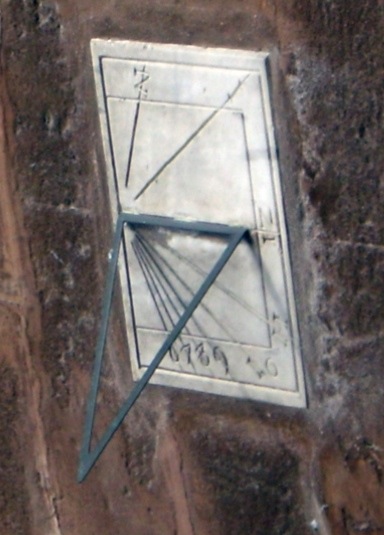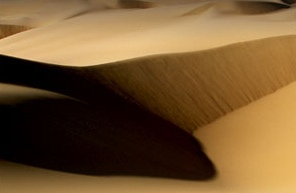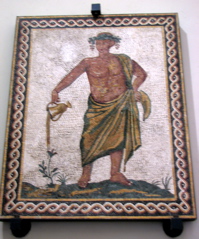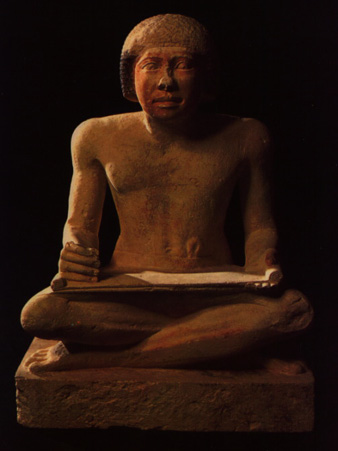 Figuratively a measure that reveals hidden knowledge, hence Gnostic one who seeks knowledge in order to comprehend Gods works in the material world.
Figuratively a measure that reveals hidden knowledge, hence Gnostic one who seeks knowledge in order to comprehend Gods works in the material world. "Keeping time"
Gnomon: a device to track time by the sun's shadow.
 Figuratively a measure that reveals hidden knowledge, hence Gnostic one who seeks knowledge in order to comprehend Gods works in the material world.
Figuratively a measure that reveals hidden knowledge, hence Gnostic one who seeks knowledge in order to comprehend Gods works in the material world.
Quite literally the gnomon on any sundial is the one part -- called the style-- that casts a shadow. By reading where the shadow falls on the face of the dial on may discern the general time of day, the hemisphere you are in, the latitude you are at, and the season of the year --all with respect to the length of the shadow.
Determining the time: US Naval Observatory 
The first reported western person to have understood that the difference in the length of shadows between the upper and lower Nile was the Greek geometer and mathematician, Eratosthenes. He used the differences at Alexandria and upper Egypt in what is now Aswan (closer to the equator) in determining the Earth's circumference by using the differences in the relative length of the shadows cast in these two different places precisely at noon on the same day.
 The accuracy of his measure depends on your sources. Pliny, the natural historian, suggested that Eratosthenes was very accurate in that he gave the length of the circumference of the Earth as 250,000 stadia. If a stadia equals a one mile the precision based on his observations was uncanny in its exactness. Because a shadow cast by the sun indicates both your location and the time of day, the sundial is a revealing instrument.
The accuracy of his measure depends on your sources. Pliny, the natural historian, suggested that Eratosthenes was very accurate in that he gave the length of the circumference of the Earth as 250,000 stadia. If a stadia equals a one mile the precision based on his observations was uncanny in its exactness. Because a shadow cast by the sun indicates both your location and the time of day, the sundial is a revealing instrument.
By authority, a sundial puts the place where it is located in a geographical relationship to the Earth, that we call latitude. The specific angle of the shadow of the sun during the course of a day and the more generally the direction at which the shadow is cast can tell you the time of day and the location of place.
The so-called Julian Calendar of 46 BCE, was an attempt to rectify solar and lunar means of dividing up the duration and seasonal changes accompanying annular changes in the heavens. The original Roman calendar consisted of 10 months of 30 days each with an additional day every fourth month, for 304 days.
A day is the duration from one sun period (determined by sunset or sunrise depending on the culture) to the next repetition of that period. For example the Babylonians defined a day as starting as the sun was at the apex in the noon sky.
"Around 2000 BC, the Babylonians created the system of the zodiac to describe the positions of the planets. In the 8th century BC, they defined the day as starting when the Sun was at the highest point in the sky." They persisted in keeping a calendar based on the more obvious periodicity of the moon which lasts 28.5 days in which the shape of the sun's rays falling on the moon as it orbits the Earth changes form in a regular progression from crescents to fullness and back to crescents prior to its total disappearance. "The Babylonians finally systematized a strictly lunar calendar which began with the first visible crescent moon around 500 BC." This of course required careful observations of the night sky.
Originally the Mediterranean year began in March when the rains normally slacken and the brown parched plants turn to green under the influence of winter rains.

The decimal system of Roman months were:
In the 6th century BCE the Romans calculated the necessity to add two more months (lunar periods) to their ten month calendar. February [ the month of expiation -- "appeased by sacrifice" ] and January were the result. The final month named for Janus the twin headed deity of endings and beginnings.
"During 46 BCE, the Greek astronomer Sosigenes convinced Julius Caesar to reform the Roman calendar" to make it more accurate. Having created Alexandria in Egypt the Greeks were rightly impressed by the accuracy of the Egypt ion calendar based as it was on accurate astronomy.

"The ancient Egyptians began numbering their years when the star Sirius rose at the same place as the Sun. The Egyptian calendar was the first solar calendar and contained 365 days."
As early as "1000 BC, the Egyptians put the solar calendar, which consisted of 12, 30-day months with five extra festival days at the end of the year, into use.
This reckoning of time based on the earth's position about the sun required no astronomical adjustments or observations and became the standard used throughout the Middle Ages and used by Copernicus.
It is from the Egyptians that we derive our concept of time, conceptions of creation out of the muds and clays of river sediment, ideas concerning living life and judgment at death, about the divinity of the trinity, imagery, writing, libraries as repositories of discoverable information, grain based diets, domesticated cats, and the immortality of the soul as an expression of creation.
Egypt is at once our origins and mirror into which we see a repeated regression of human creation and natural destruction in a sort of perverted harmony. Once deep inside a tomb or temple ruin along the river Nile, the antiquity of this civilization spread-out as it is along this elongated flood plain is as palpable as any other placement of humanly arranged structures. Egypt's places echo of lust and hardship, confidence and diffidence, order and anarchy in ways that remind us of human striving is always demarcated by folly and that human error is forever a means of reconciling ambition with defects. Time is but one of those concepts riddled with defective ambition.
In Greek stories Chronos, or the deification of time, devours his children as depicted in this painting by Goya.
